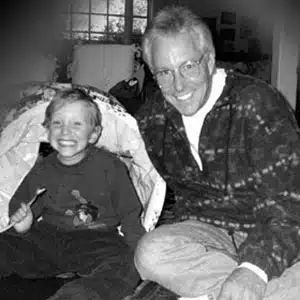For me, the hardest part of Charlie’s seizures was seeing his eyes. You don’t hear much about the eyes. One minute they were bright, smiley, clear. A split second later, they were dull, unfocused… dead. Then they’d roll back. It was like watching him die. The rest of the seizure, whether it was a quick drop or his body stiffening and shaking with a high piercing noise, was terrifying and heartbreaking. But for some reason what has stuck with me most are his eyes. No matter how often it happened, no matter how many hundreds of times I saw them, it never got easier.There is nothing good about epilepsy. There are so many indelible images—the seizures; the falls and the stitches; the races to the hospital; the panic, guilt, and unfairness; the drug reactions; watching his tiny body roll into brain surgery; the crushed hopes; his fading away; the frustration; the devastation of the family; the despair, anger, fear, and sadness. Every time the phone rings, your heart drops. Every time you’re driving in your neighborhood and you hear an ambulance, you race home to see if it’s coming for your child. Unlike so many other families, though, we were incredibly fortunate with Charlie. After monotherapy and then endless drug cocktails failed, I started doing my own research and stumbled across the ketogenic diet— a nearly extinct, high-fat diet for kids with intractable epilepsy that is known to help control and often even stop seizures. With the advent of new drugs, the diet—once a first line of therapy—had fallen into disuse. However, we were able to find a dietitian who was familiar with it and who was willing to start Charlie on it right away.
His seizures went away in two days. He stopped taking drugs within a month, and his development returned. It was a miracle.
That was fourteen years ago. After five years on the diet, he began to eat regular foods again and the seizures have never come back.
When you have a kid as sick as Charlie was, a hundred times a day you say, “Oh please God, make the seizures go away. I’ll do anything.” Then, when they did go away and we began to trust that it had really happened, I looked up and sure enough, there was God, patiently drumming his fingers. Charlie’s seizures had stopped, and now it was my turn to make good on my promise—I had to do anything I could to help other families who were living the nightmare from which we had finally awoken.
So, I asked Charlie’s doctor why we had to learn about the diet on our own—why none of his other doctors had ever told us about it. He believed the diet would never become accepted as a conventional treatment because of the way our medical establishment shares information.
My life took on new purpose. The ketogenic diet had to be made an option—an early option. Because doctors weren’t informing families about this treatment option, were misinforming them, or were administering the diet improperly, this information needed to go directly to the families. My wife Nancy and I started The Charlie Foundation To Help Cure Pediatric Epilepsy.
And then there are those for whom the diet just doesn’t work the way it did for Charlie.
For those families the nightmare of uncontrollable seizures just goes on and on and there is only hope to cling to. Hope that their miracle is around the corner. Hope that epilepsy research will get its just share of funding. Hope that their child’s suffering will have some end, or at least some purpose. I can tell you that the darkest hour is when there is a loss of hope.
And that’s the tremendous importance of CURE. Someday there will be an end to epilepsy, and CURE is bringing that day closer. I’ve watched CURE grow from simply a dream to a powerful force in the worlds of epilepsy awareness and research. And I know that its influence will continue to grow and impact until the last seizure has subsided, until the last child’s brain has been damaged, and until the last parent has had to endure watching a son or daughter’s terrifying eyes.





